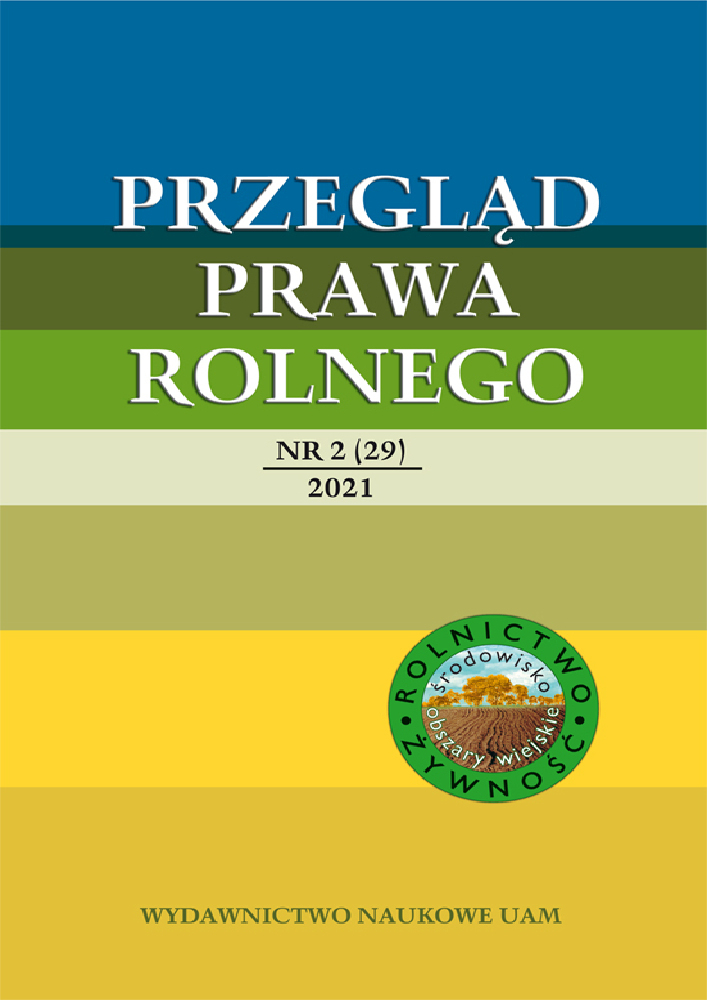Abstract
The main objective of this article is to determine the level of protection of the welfare of farmed animals at the time of slaughter. The analysis of international, European as well as national laws indicates a general assumption that the life of animals is a legally protected good. However, there are certain exceptions to this principle, one of the being the slaughter of farmed animals for the purpose of obtaining certain products of animal origin. Generally speaking, protection of farmed animals during slaughter is reduced to the protection of their welfare and assurance of their most humane treatment, if such is at all possible in a situation of killing. The main protective instrument provided for this is the obligation to stun the animals to effectively render them insensible to environmental stimuli. A derogation from this requirement is only envisaged for ritual slaughter. As can be seen, protection of animals at the time of killing, as well as the effective control of such a procedure, poses certain problems.
References
Cartoni Mancinelli A., Dal Bosco A., Mattioli S., Ranucci D., Castellini C. (2018), Mobile poultry processing unit as a resource for small poultry farms: planning and economic efficiency, animal welfare, meat quality and sanitary Implications, „Animals” nr 8(12).
Gabriel-Węglowski M. (2008), Przestępstwa przeciwko humanitarnej ochronie zwierząt, Toruń.
Gębska M., Gołębiewska B., Grontkowska A. (2018), Dobrostan zwierząt gospodarskich. Od teorii do praktyki, Warszawa.
Girasole M., Chirollo C., Ceruso M., Vollano L., Chianese A., Cortesi M.L. (2015), Optimization of stunning electrical parameters to improve animal welfare in a poultry slaughterhouse, „Italian Journal of Food Safety” nr 4(3).
Goździewicz-Biechońska J., Jachnik E. (2021), Legal Status of the Animal as a Determinant of Its Humanitarian Protection, „Studia Iuridica Lublinenisia” nr 3(30).
Jachnik E. (2016), Prawne aspekty uboju rytualnego, „Przegląd Prawa Rolnego” nr 1(18).
Kojzar K., „To nie są zwierzęta wystawowe”. Co zdarzyło się w ubojni w Witkowie?, https://oko.press/to-nie-sa-zwierzeta-wystawowe-co-sie-zdarzylo-w-ubojni-w-witkowie-rzeznia-odc-1/ [dostęp: 12.09.2021].
McNulty P., Grace P.M. (2009), Encyclopedia of life support systems. Agricultural mechanization and automation, Oxford.
Miele M. (2016), Killing Animals for Food: How Science, Religion and Technologies Affect the Public Debate About Religious Slaughter, „Food Ethics” t. 1.
Mroczek R. (2020), Analiza wpływu regulacji związanych z „wygaszaniem” branży futrzarskiej w Polsce (m.in. w zakresie zagospodarowania przez nią odpadów poubojowych) np. w zakresie ewentualnego wzrostu cen mięsa i wędlin czy następstw likwidacji uboju rytualnego – dla rolnictwa w Polsce i innych branż (m.in. spadku poziomu rentowności poszczególnych działów gospodarki), ekspertyza, https://www.senat.gov.pl/download/gfx/senat/pl/senatinicjatywypliki/8575/4/209_ekspertyzaks.pdf [dostęp: 31.08.2021].
Mroczek R. (2021), Ubój religijny zwierząt rzeźnych w Polsce, „Zagadnienia Ekonomiki Rolnej” nr 1(366).
Mroczkowski S., Frieske A. (2016), Regulacje użytkowania zwierząt, Bydgoszcz.
Nind F., Bro-Jorgensen O., Meisser A., Udo A.W., Zemljic B. (2017), Slaughter of Animals without Prior Stunning, FVE Position Paper, Brussels, https://www.veterinaire.fr/fileadmin/user_upload/documents/outils-et-services/Index_juridique/Premiere_lettre_de_M_a_Z/Religious_slaughter_and_food_chain.pdf [dostęp: 14.06.2021].
Radecki W. (2015), Ustawy o ochronie zwierząt. Komentarz, Warszawa.
Urban-Chmiel R. (2013), Kryteria dobrostanu zwierząt podczas uboju w świetle dyrektywy nr 1099/2009 obowiązującej od 1 stycznia 2013 r., „Życie Weterynaryjne” nr 2(88).
License
Copyright (c) 2021 Eliza Jachnik

This work is licensed under a Creative Commons Attribution-ShareAlike 4.0 International License.





